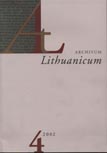Iron-gall ink and ink corrosion
Iron-gall ink and ink corrosion
Author(s): Ad StijnmanSubject(s): History of ideas, Sociology of Art
Published by: Lietuvių Kalbos Institutas
Keywords: Iron-gall ink; type of writing;
Summary/Abstract: Since the early Middle-Ages a particular kind of ink was used more and more for writing and drawing, the so-called "iron-gall ink". This ink is a chemical compound made by the reaction of iron sulphate with tannin extracted from gall nuts. From the 10th up to the 20th century this type of ink became the most popular writing medium in Europe and its colonies. In the 18th century doubt arose about the long term stability of the ink, as text and drawings started to fade. Much worse: the paper and parchment underneath and around the lines were corroded and in some cases completely eaten away by some sort of chemical action. In 1898 the first international congress on ink-corrosion met in St. Gallen. Since then international research into the ink's chemical processes and treatment methods increased more and more. In 2002 a major step forward was made by the start of the European InkCor project. This article summarises the state of the art of the research into ink and ink corrosion, for more details see the ECPAand InkCor websites.
Journal: Archivum Lithuanicum
- Issue Year: 2002
- Issue No: 04
- Page Range: 171-178
- Page Count: 8
- Language: English

